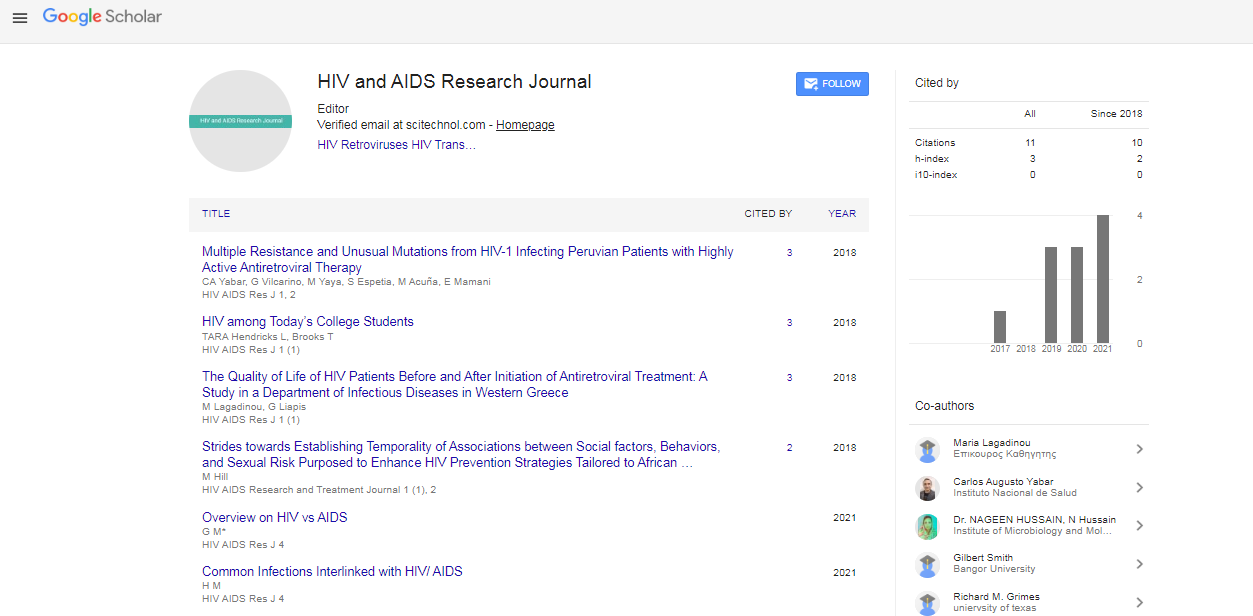Commentary, Hiv Aids Res J Vol: 6 Issue: 2
Exploring the Strategies of HIV Vaccines and Their effects on Global Health
Stever Karen*
1Department of Medicine, University of Toronto, Toronto, Canada
*Corresponding Author: Stever Karen,
Department of Medicine, University of
Toronto, Toronto, Canada
E-mail: stever_karen@ut42.ca
Received date: 23 August, 2023, Manuscript No. HARJ-23-118053;
Editor assigned date: 25 August, 2023, PreQC No. HARJ-23-118053 (PQ);
Reviewed date: 08 September, 2023, QC No. HARJ-23-118053;
Revised date: 15 September, 2023, Manuscript No. HARJ-23-118053 (R);
Published date: 22 September, 2023, DOI: 10.4172/Harj.1000127
Citation: Karen S (2023) Exploring the Strategies of HIV Vaccines and Their effects on Global Health. HIV AIDS Res J 6:2.
Keywords: Stever Karen
Description
HIV, the human immunodeficiency virus, has posed a formidable global health challenge for decades. The quest for a safe and effective HIV vaccine has been ongoing, and while we are not there yet, significant progress has been made. HIV remains a global pandemic, with over 38 million people living with the virus worldwide. The development of a vaccine has been a high-priority goal, as it provides the potential to control and eventually end the epidemic. However, HIV is an incredibly complex virus with unique challenges, including high mutation rates and the ability to evade the immune system.
The development of an HIV vaccine has been a multi-decade effort marked by significant breakthroughs and challenges. Several strategies have been explored, each aiming to stimulate an effective immune response against the virus. Here are the primary vaccine strategies and their mechanisms. These vaccines use weakened, but still living, forms of the virus to stimulate an immune response. The mechanism involves replicating HIV in a controlled manner, triggering a robust immune reaction. However, these vaccines come with safety concerns and have not yet reached clinical use.
Inactivated or killed vaccines use non-infectious components of the virus to stimulate an immune response. While these vaccines are safe, they have shown limited efficacy against HIV. Protein subunit vaccines use pieces of the virus, typically viral proteins, to trigger an immune response. These components are safe and well-tolerated, but they often generate a weaker immune response compared to live vaccines. Viral vector vaccines involve modifying a harmless virus to carry a piece of HIV genetic material. This approach triggers a strong immune response. Successful prospects like the Ad26-based mosaic vaccines are currently in advanced clinical trials.
DNA vaccines involve the use of small pieces of HIV DNA to stimulate an immune response. These vaccines are still under investigation, and their development is ongoing. RNA vaccines use a small piece of HIV's genetic material (messenger RNA) to instruct cells to produce viral proteins, thereby eliciting an immune response. The mRNA technology employed in COVID-19 vaccines is an example of this strategy, which has demonstrated great potential.
The development of a potent HIV vaccine has enormous potential for improving world health. Here's how these vaccine strategies, if successful, could positively impact the fight against HIV. An effective HIV vaccine could significantly reduce the number of new HIV infections globally. This would be particularly vital in high-prevalence regions and among key populations at risk.
A widely deployed vaccine could contribute to the ultimate goal of ending the HIV/AIDS pandemic. Reducing the number of new infections is an essential step towards achieving this goal. By reducing the number of new infections, the burden on healthcare systems, especially in low and middle-income countries, would decrease. This, in turn, would alleviate the costs associated with treatment and longterm care. A vaccine that prevents HIV infections could lead to healthier, more productive populations, particularly in regions heavily impacted by the virus. This could, in turn, stimulate economic growth and development.
Conclusion
The development of an HIV vaccine remains an important goal in the global fight against HIV or AIDS. The impact of such vaccine on global health would be profound, potentially leading to a significant reduction in new infections, improved access to care and treatment, and a step closer to ending the epidemic. While challenges remain, technological innovation and adherence to this cause persist. As the world has witnessed with the rapid development of COVID-19 vaccines, advancements in vaccine technology provide hope that an effective HIV vaccine may eventually become a reality, changing the course of the HIV or AIDS pandemic.
 Spanish
Spanish  Chinese
Chinese  Russian
Russian  German
German  French
French  Japanese
Japanese  Portuguese
Portuguese  Hindi
Hindi 